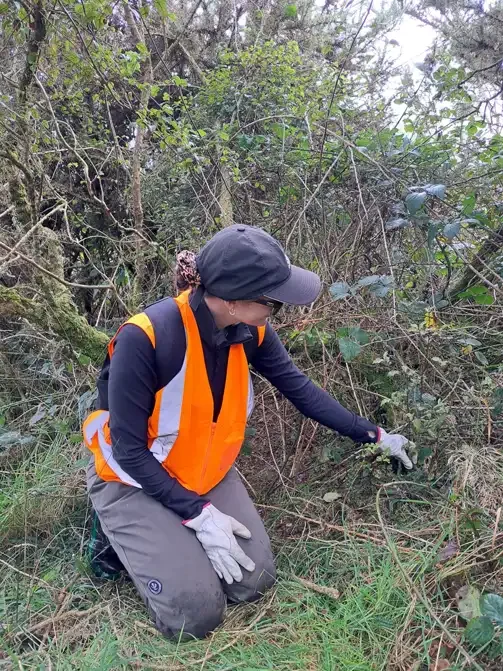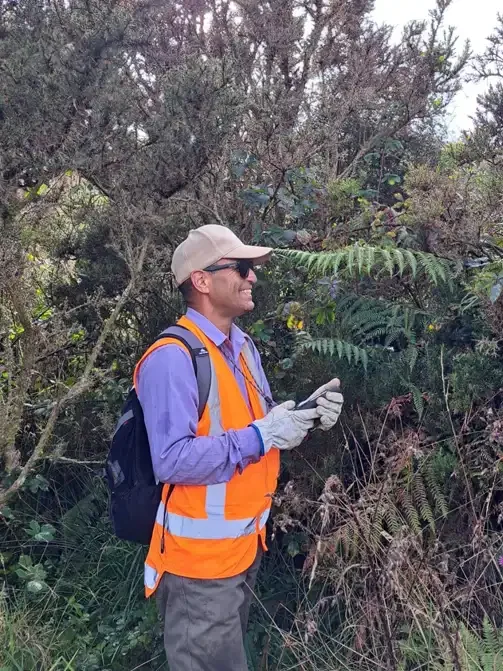Nature-Based Solutions Team Insights
Meet the Nature-Based Solutions team— Sean, Narendra, Aimee and May. Their work plays a crucial role in assessing and supporting forest carbon projects, from analysing data at their desks to conducting hands-on fieldwork. In this interview, Aimee gives us an inside look at their daily activities, the tools they rely on, and what makes their work both challenging and rewarding. Read on to learn more about their role and how they contribute to meaningful positive environmental impact.
- Aimee looking at a regenerating matipo seedling during a vegetation assessment
- Narendra locating a sample plot and about to enter the gorse during a vegetation assessment
What does a typical day look like for the NBS team?
Our day can vary depending on whether we need to be in the field. Most of our desktop work is looking at ETS eligibility of properties, helping landowners with forest carbon project development, financial modelling, data analysis from field measurements, as well as consulting work. When we are in the field we can be working on vegetation assessments (which often involves lots of crawling through gorse), site inspections, assessing ETS compliance, carbon and biodiversity monitoring.
What is your ‘go-to’ software and what do you use it for?
QGIS is the main one. This is a mapping software widely used by the industry and we use it every day. We use it to process mapping data, draw polygons, undertake historical imagery analysis and create maps. Other than QGIS, we mainly use excel for data analysis and carbon/financial modelling, and an online information management platform called BlueLayer.
What do you observe in the field on a typical field trip to a carbon forestry project?
We observe a variety of things whether it is in a native planting, natural regeneration or an exotic transition to native forest scenario. The most interesting observations during field work occur in our vegetation assessments. This is where we forage through dense bush and gorse to find regenerating natives. In some cases we have to chop through gorse with our mini electric saw pruner to find our way to the sample point which is a fun challenge and typically very rewarding when you find an abundance of native seedlings under the gorse.
Another factor to our field work is observing if there is any pest sign, whether it be pug marks from deer, uprooting of soil and vegetation from pigs, or 45 degree cut marks on stems from hare. We also monitor pest traps in action such as the AT220 traps (automatic pest trap).
In some cases we need to take measurements from forests such as the diameter at breast height (DBH) and the height of the trees (m). To do this we use a diameter tape measure and we use a vertex laser instrument for tall trees and a height pole for smaller trees.
All in all we make many observations during our time in the field and use a variety of equipment which makes it interesting and very rewarding work.
What is the best part of working on the Nature-Based Solutions team?
We get to engage with landowners frequently and I really enjoy building relationships with our clients and learning about their projects, their objectives, their goals and passions. We are very lucky to work with our clients and have had some fantastic field trips working alongside landowners and sharing with them more about the work we do and the process of setting up a forest carbon project. It is lovely to connect and align with hard working and like-minded people wanting to do good for the planet.
What is a helpful tip for someone looking to build a forest carbon project?
Get in touch! Use the contact form on our website to get in touch with one of our team members. If you are interested particularly in creating an ETS project, then please go straight to the free eligibility assessment survey and we can set a meeting from there to go over the results. For any other enquiries please send us an email via the contact form.


